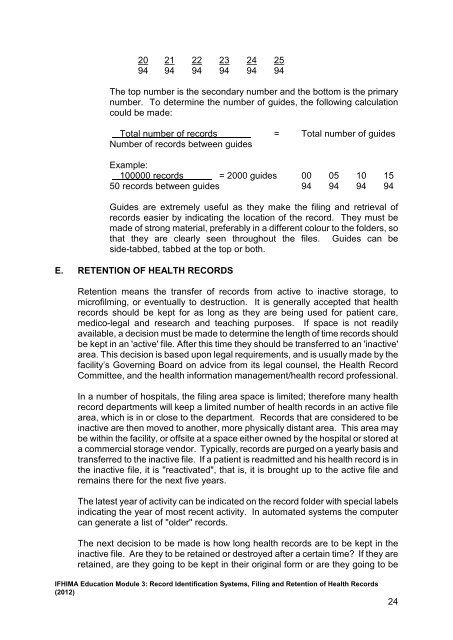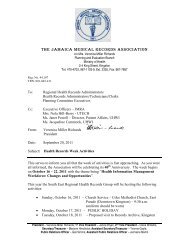Learning Packages for Medical Record Practice - ifhima
Learning Packages for Medical Record Practice - ifhima
Learning Packages for Medical Record Practice - ifhima
You also want an ePaper? Increase the reach of your titles
YUMPU automatically turns print PDFs into web optimized ePapers that Google loves.
20 21 22 23 24 25<br />
94 94 94 94 94 94<br />
The top number is the secondary number and the bottom is the primary<br />
number. To determine the number of guides, the following calculation<br />
could be made:<br />
Total number of records<br />
Number of records between guides<br />
= Total number of guides<br />
Example:<br />
100000 records = 2000 guides 00 05 10 15<br />
50 records between guides 94 94 94 94<br />
Guides are extremely useful as they make the filing and retrieval of<br />
records easier by indicating the location of the record. They must be<br />
made of strong material, preferably in a different colour to the folders, so<br />
that they are clearly seen throughout the files. Guides can be<br />
side-tabbed, tabbed at the top or both.<br />
E. RETENTION OF HEALTH RECORDS<br />
Retention means the transfer of records from active to inactive storage, to<br />
microfilming, or eventually to destruction. It is generally accepted that health<br />
records should be kept <strong>for</strong> as long as they are being used <strong>for</strong> patient care,<br />
medico-legal and research and teaching purposes. If space is not readily<br />
available, a decision must be made to determine the length of time records should<br />
be kept in an 'active' file. After this time they should be transferred to an 'inactive'<br />
area. This decision is based upon legal requirements, and is usually made by the<br />
facility’s Governing Board on advice from its legal counsel, the Health <strong>Record</strong><br />
Committee, and the health in<strong>for</strong>mation management/health record professional.<br />
In a number of hospitals, the filing area space is limited; there<strong>for</strong>e many health<br />
record departments will keep a limited number of health records in an active file<br />
area, which is in or close to the department. <strong>Record</strong>s that are considered to be<br />
inactive are then moved to another, more physically distant area. This area may<br />
be within the facility, or offsite at a space either owned by the hospital or stored at<br />
a commercial storage vendor. Typically, records are purged on a yearly basis and<br />
transferred to the inactive file. If a patient is readmitted and his health record is in<br />
the inactive file, it is "reactivated", that is, it is brought up to the active file and<br />
remains there <strong>for</strong> the next five years.<br />
The latest year of activity can be indicated on the record folder with special labels<br />
indicating the year of most recent activity. In automated systems the computer<br />
can generate a list of "older" records.<br />
The next decision to be made is how long health records are to be kept in the<br />
inactive file. Are they to be retained or destroyed after a certain time? If they are<br />
retained, are they going to be kept in their original <strong>for</strong>m or are they going to be<br />
IFHIMA Education Module 3: <strong>Record</strong> Identification Systems, Filing and Retention of Health <strong>Record</strong>s<br />
(2012)<br />
24













